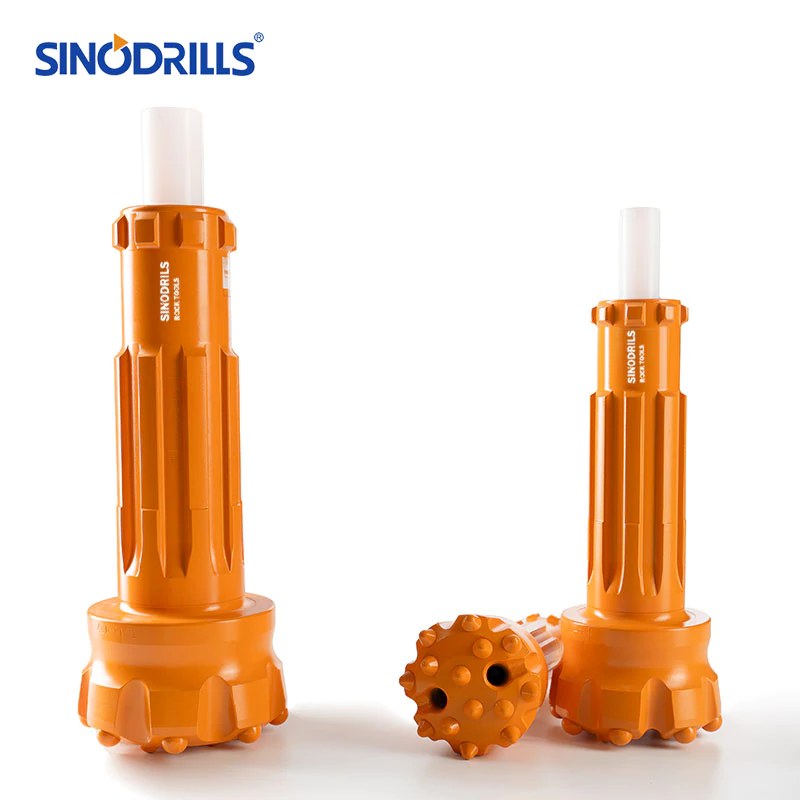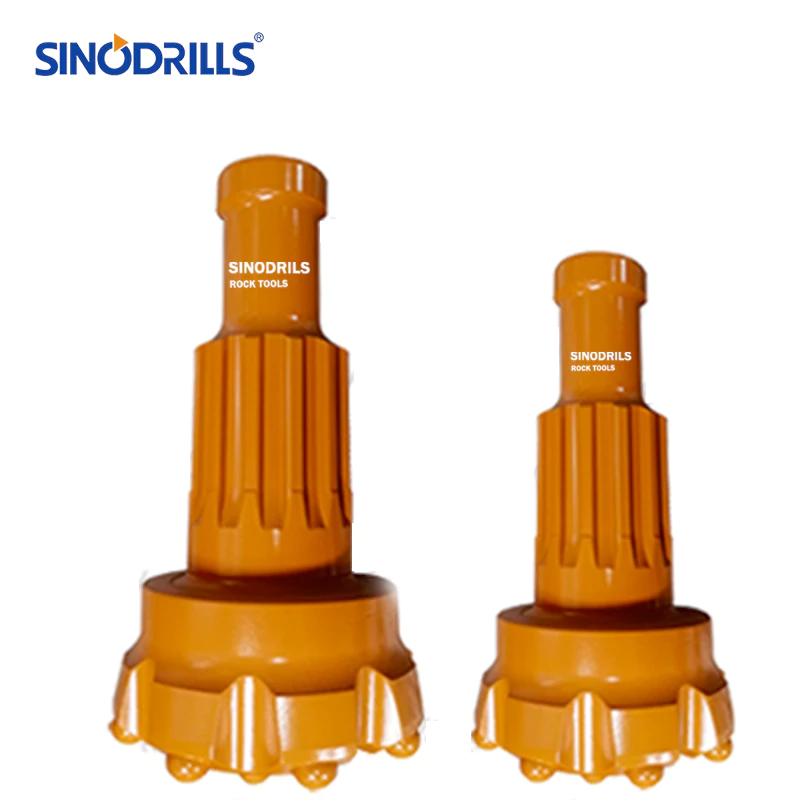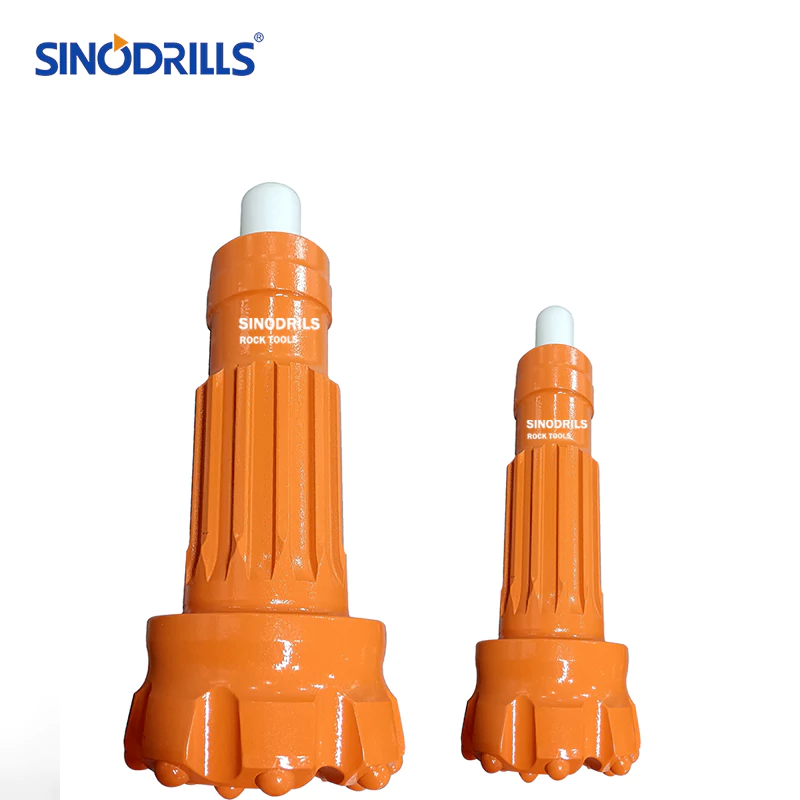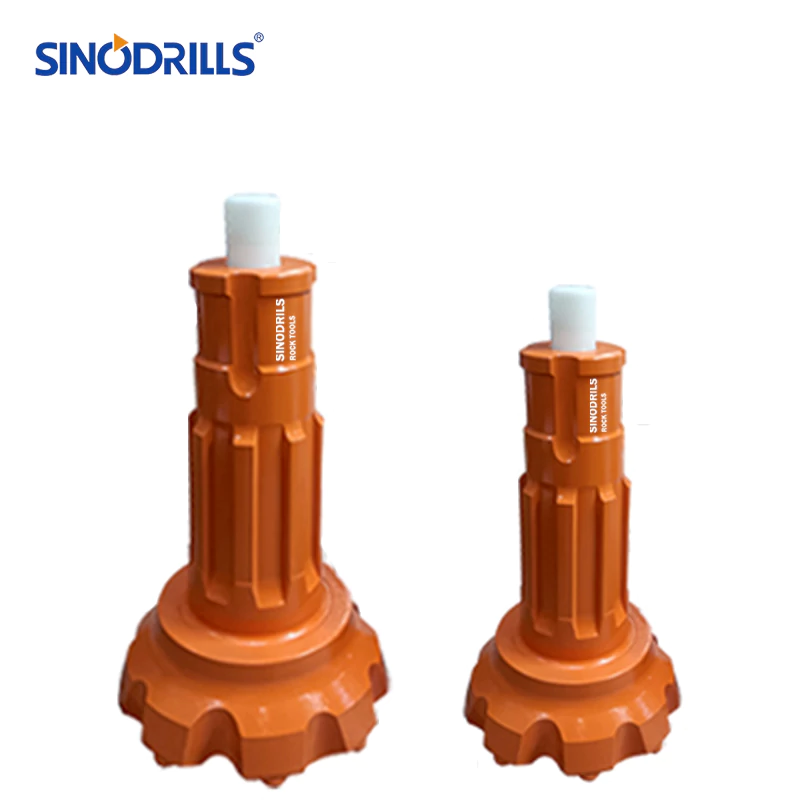Choosing the correct drill bit shank type is paramount for maximizing your drilling efficiency, ensuring safety, and prolonging the life of both your drill bits and power tools. The shank is the part of the drill bit that fits into the chuck of your drill, and its design dictates how securely it’s held, how effectively torque is transferred, and what kind of drill it can be used with.
Understanding the various drill bit shank types available, from common cylindrical shanks to more specialized designs, will empower you to select the perfect bit for your specific application. This guide will walk you through the key considerations, helping you make informed decisions that lead to cleaner holes, faster work, and a more reliable drilling experience every time.
What is a Drill Bit Shank
The drill bit shank is the cylindrical or specially shaped end of a drill bit that is inserted into and gripped by the chuck of a drilling machine, such as a hand drill, drill press, or rotary hammer. It’s the non-cutting part of the drill bit that transmits the rotational force and, in some cases, the percussive impact from the drill to the cutting end.
The design of the shank is crucial for ensuring a secure fit, preventing slippage during operation, and efficiently transferring power to the drill bit’s cutting edges. Different shank types are designed to be compatible with specific chucks and to optimize performance for various drilling applications and materials.
Drill Bit Shank Types
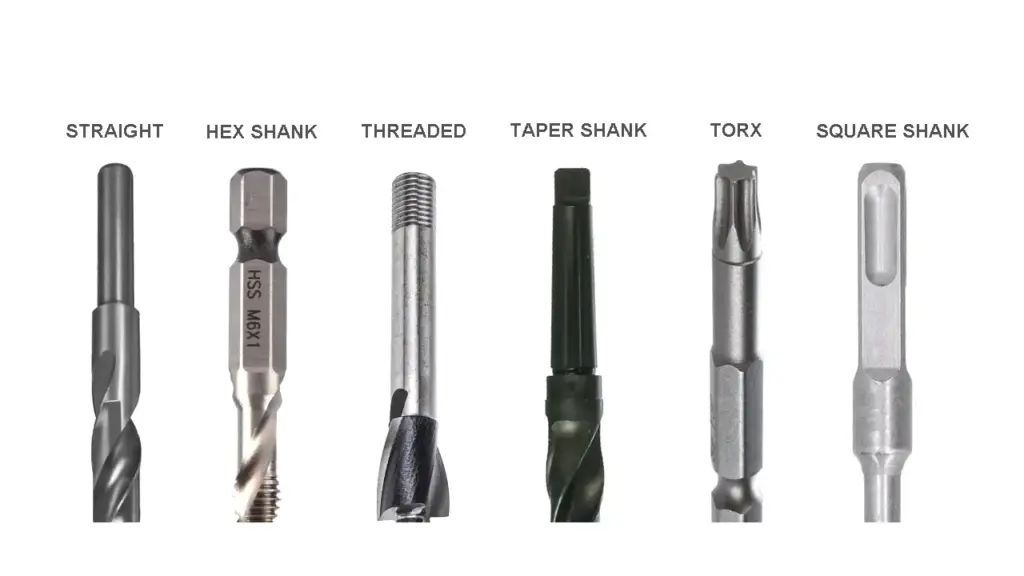
The drill bit shank is the crucial connection point between your drill bit and the power tool. Its design dictates how securely the bit is held, how efficiently power is transferred, and ultimately, the types of drilling applications it’s best suited for. Understanding the different shank types is key to choosing the right tool for optimal performance and safety.
DTH Shank Types
Recommended DTH Drill Bits
DTH (Down-The-Hole) drill bits have specialized shanks that connect to DTH hammers, not standard drill chucks. These shanks are designed to withstand extreme percussive forces and high torque, ensuring reliable power transmission directly to the rock face for efficient drilling. They feature unique splines or lugs for a secure, non-slip fit within the hammer.
Features: DTH shanks are characterized by robust, often splined or fluted designs at their rear. These features allow the shank to lock securely into the DTH hammer, transmitting both rotational torque and high-frequency percussive blows. They are typically made from hardened alloy steel for extreme durability.
Benefits: The primary benefit of DTH shanks is their ability to withstand the intense impact and rotational forces of a DTH hammer. This robust connection ensures maximum energy transfer to the bit, leading to high penetration rates and extended tool life. It also prevents slippage during drilling.
Uses: DTH shanks are exclusively used with DTH hammers in heavy-duty rock drilling applications. These include mining for blast holes, quarrying for stone extraction, water well drilling in hard rock, and large-scale construction projects requiring deep, accurate boreholes in challenging ground.
Round Shank
The round shank is the most common and basic type of drill bit shank. It has a smooth, cylindrical shape that fits into a standard three-jaw chuck, which grips the shank around its circumference. Its simplicity makes it widely compatible with various drilling machines, from handheld drills to drill presses.
Features: Round shanks are characterized by their perfectly circular cross-section and smooth surface. They rely on the clamping force of the drill chuck’s jaws to hold the bit securely in place. They come in various diameters, often corresponding to common drill chuck sizes.
Benefits: The main benefit of round shanks is their broad compatibility with almost all standard drill chucks. They are versatile, easy to insert and remove, and generally less expensive to manufacture, making them a popular choice for general-purpose drilling tasks.
Uses: Round shank drill bits are widely used for general drilling in wood, plastic, and softer metals. They are common in DIY projects, light-duty construction, and everyday workshop tasks where precise torque transfer and slip prevention are not the absolute top priority.
Straight Shank
A straight shank is essentially another term for a round shank. It refers to any drill bit shank that has a uniform, cylindrical diameter along its entire length that is inserted into the chuck. This type of shank is incredibly common due to its simplicity and broad compatibility with standard chucks.
Features: Straight shanks are defined by their uniform, cylindrical shape without any flutes, flats, or grooves beyond the gripping area. They are precision-ground to ensure a consistent diameter, which allows them to be securely held by the jaws of a standard drill chuck.
Benefits: The key benefit of straight shanks is their universal compatibility with most common drill chucks, making them highly versatile for general drilling tasks. Their straightforward design is also cost-effective to produce, contributing to their widespread availability.
Uses: Straight shank drill bits are extensively used in various drilling applications, including general-purpose drilling in wood, metal, plastic, and composite materials. They are found in twist drills, spade bits, and many specialized bits for everyday use.
Hex Shank
Hex shanks feature a hexagonal cross-section, providing a greater surface area for the drill chuck to grip compared to a round shank. This design is particularly effective at preventing slippage, especially when dealing with higher torque applications or when using impact drivers.
Features: Hex shanks have a six-sided, hexagonal shape, typically measuring 1/4 inch (6.35 mm) across the flats for quick-change applications. They are designed to fit securely into hex chucks or adapters, preventing rotation within the chuck under high torque.
Benefits: The primary benefit of hex shanks is their superior grip and resistance to slippage, even under high torque. They also allow for quick and easy bit changes, particularly in impact drivers, enhancing efficiency in repetitive tasks and reducing downtime.
Uses: Hex shank drill bits are commonly used in cordless drills, impact drivers, and screwdrivers for driving screws and drilling into wood, metal, and plastic. Their anti-slip properties make them ideal for tougher drilling tasks and high-volume work.
SDS Shank
SDS (Slotted Drive System) shanks are specifically designed for use with rotary hammer drills, offering both rotary and hammer action. They feature distinct indentations and slots that allow the bit to move freely within the chuck while remaining securely locked for rotation.
Features: SDS shanks have a unique design with distinct slots and sometimes detents. These slots engage with corresponding features in the SDS chuck, allowing the bit to slide axially for hammering while preventing rotational slippage. There are SDS-Plus and larger SDS-Max variants.
Benefits: SDS shanks are highly effective for drilling in hard materials like concrete, masonry, and stone due to their ability to efficiently transmit both rotary and percussive energy. The quick-change mechanism allows for fast, tool-free bit swaps.
Uses: SDS shank drill bits are predominantly used in rotary hammer drills for drilling into concrete, brick, stone, and other masonry materials. They are essential tools for construction, demolition, and any application requiring heavy-duty drilling in tough materials.
Reduced Shank
Reduced shanks, also known as “silver and deming” bits, feature a shank diameter that is smaller than the cutting diameter of the drill bit itself. This design allows larger drill bits to be used in drill chucks that have a smaller maximum gripping capacity, extending the versatility of smaller drills.
Features: The distinguishing feature of a reduced shank is its cylindrical portion at the back, which has a smaller diameter than the fluted cutting section of the drill bit. This enables a large cutting diameter to be driven by a smaller chuck.
Benefits: The main benefit is the ability to drill larger holes than what would normally be possible with the limitations of a standard drill chuck. This saves the expense of needing a larger drill or specialized chucks for occasional large-diameter drilling.
Uses: Reduced shank drill bits are commonly used in general-purpose drilling with standard drill presses or handheld drills when a larger hole size is required than the chuck can normally accommodate. They are popular in metalworking and woodworking.
Morse Taper Shank
Morse taper shanks are self-holding, conical shanks that rely on a precise taper fit within a corresponding tapered spindle or sleeve of a drilling machine. They provide a very strong and accurate connection, making them ideal for heavy-duty drilling where precision and stability are critical.
Features: Morse taper shanks have a precise conical taper (available in different sizes, e.g., MT1, MT2, MT3). They are typically smooth and rely on friction and wedging action for grip, often featuring a tang at the end for positive drive or for knockout.
Benefits: The primary benefit is their extremely strong and stable connection, which resists slippage even under very high torque. They also ensure excellent concentricity, leading to highly accurate holes, and allow for quick, tool-free bit changes.
Uses: Morse taper shank drill bits are widely used in industrial settings with drill presses, lathes, and milling machines where heavy-duty drilling and high precision are required, such as in metal fabrication, machinery manufacturing, and large-scale construction.
Brace Shank
Brace shanks, also known as “bit stock” shanks, are specifically designed for use with a carpenter’s brace. They feature a square-tapered end that wedges into the square socket of the brace’s chuck, providing a secure, non-slip connection for hand-powered drilling.
Features: Brace shanks are characterized by their distinct square and tapered end. This design allows them to fit perfectly into the square opening of a brace’s chuck, ensuring a firm, non-rotational grip for manual drilling operations.
Benefits: The main benefit of brace shanks is their compatibility with traditional hand braces, allowing for precise, controlled, and quiet drilling without electricity. They offer excellent torque transfer for manual drilling through wood.
Uses: Brace shank drill bits are primarily used in woodworking by craftsmen and for traditional carpentry tasks where a power drill is not available or desired. They are common with auger bits and expansive bits for drilling large holes in timber.
Triangle Shank
Triangle shanks are a type of modified round shank where three flats are ground onto the cylindrical surface, forming a triangular profile. This design aims to improve grip and prevent slippage in standard three-jaw drill chucks compared to a completely smooth round shank.
Features: Triangle shanks have three flat surfaces evenly spaced around a cylindrical core. This provides more contact points for the chuck jaws than a purely round shank, increasing the gripping force and resisting rotation within the chuck.
Benefits: The benefit of triangle shanks is enhanced grip and reduced slippage in standard drill chucks, especially when applying higher torque. This can lead to more consistent drilling and less wear on the chuck jaws compared to smooth round shanks.
Uses: Triangle shank drill bits are commonly found on twist drills and other general-purpose bits used in handheld drills or drill presses. They are suitable for drilling in various materials where improved grip over a basic round shank is desired.
Square Shank
Square shanks are less common in modern power drilling but were historically used for certain specialized applications or with specific types of drilling tools. They feature a square cross-section along their entire length or at the gripping end.
Features: Square shanks possess a uniform square cross-section. Depending on the application, they might fit into square drive sockets or specialized chucks designed to engage the square profile for positive rotation.
Benefits: In specific historical or niche applications, the square shape could provide a very positive, non-slip drive when fitted into a corresponding square socket. This offers strong torque transfer without reliance on clamping force.
Uses: While largely superseded by other designs in general drilling, square shanks might still be found on some specialized tools or for specific industrial applications where a positive square drive is required, or in older, traditional drilling setups.
Threaded Shank
Threaded shanks feature a threaded section at their non-cutting end, designed to screw directly into a corresponding threaded spindle or adapter of a drilling machine. This creates a highly secure and rigid connection, often used for specific types of core drills or reaming tools.
Features: Threaded shanks have a precisely cut thread (e.g., M16, 1 1/4″ UNC) at their end, which screws into a female threaded spindle or adapter. This creates a very tight, concentric connection between the bit and the machine.
Benefits: The main benefit of threaded shanks is the extremely secure and concentric connection they provide, which is crucial for tools that experience significant lateral forces or require high precision, such as large hole saws or reamers.
Uses: Threaded shank drill bits are commonly used with diamond core drills for concrete and masonry, large hole saws for wood and metal, and certain reaming tools. They are prevalent in specialized construction and industrial drilling applications.
Here is the table showing you the different types of drill bit shanks in the following:
| Shank Type | Description | Typical Chuck Type | Primary Advantages | Common Uses |
| DTH Shank | Splined/fluted end for specialized DTH hammer | DTH Hammer (internal mechanism) | Withstands extreme percussion, maximum energy transfer | Heavy-duty rock drilling (mining, quarrying, water wells) |
| Round (Straight) Shank | Smooth, cylindrical end | 3-jaw chuck (keyed/keyless) | Universal compatibility, economical | General drilling (wood, plastic, soft metals) |
| Reduced Shank | Shank diameter smaller than cutting diameter | 3-jaw chuck (smaller capacity) | Allows larger bits in smaller chucks | Drilling larger holes with standard drills |
| Hex Shank | Six-sided hexagonal cross-section | Hex chuck, impact driver, quick-change | Superior grip, slip prevention, fast changes | Cordless drills, impact drivers, driving screws, tougher drilling |
| SDS Shank | Slotted design for rotary hammer action (SDS-Plus, SDS-Max) | SDS chuck (specialized for rotary hammer) | Transmits rotary and percussive energy, quick-change | Concrete, masonry, stone drilling (heavy-duty) |
| Morse Taper Shank | Conical, self-holding taper with tang | Tapered spindle/sleeve | Very strong, stable, precise, self-holding | Industrial drill presses, lathes, milling machines |
| Brace Shank | Square-tapered end | Brace chuck (square socket) | Secure fit for manual drilling, controlled operation | Traditional woodworking with hand braces |
| Triangle Shank | Cylindrical with three ground flats | 3-jaw chuck | Improved grip, reduced slippage vs. round | General drilling where enhanced grip is desired |
| Square Shank | Uniform square cross-section | Square drive sockets/specialized chucks | Positive, non-slip drive (niche/historical) | Specialized tools, older machinery, specific industrial uses |
| Threaded Shank | Threaded end to screw into spindle | Threaded spindle/adapter | Extremely secure, concentric connection | Diamond core drilling, large hole saws, reaming tools |
Hammer Drill Bit Shank Types
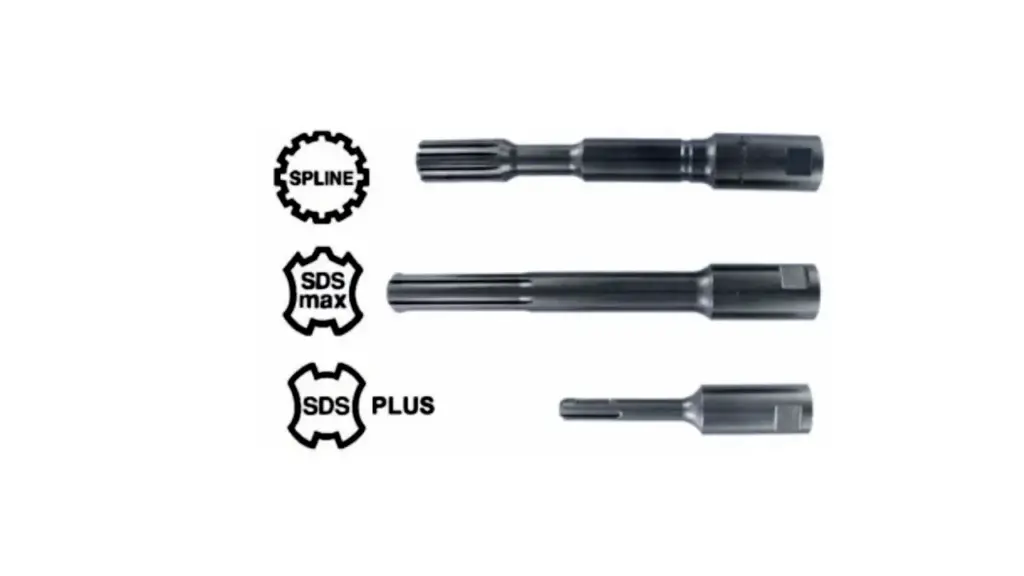
When we talk about hammer drill bit shank types, we’re specifically referring to the end of the drill bit that fits into a hammer drill (or rotary hammer). Unlike standard drills that only rotate, hammer drills also provide a powerful percussive action, meaning the drill bit shank must be designed to withstand and efficiently transmit both rotation and hammering.
This specialized requirement limits the types of shanks commonly used in hammer drills, focusing on designs that prevent slippage under impact and allow for axial movement.
SDS Shank
The SDS (Slotted Drive System) shank is the most prevalent and widely recognized shank type for modern hammer drills. Its design allows the bit to move freely within the chuck for the hammering action, while still providing a secure rotational lock. This system revolutionized masonry drilling.
Features: SDS shanks feature distinctive open grooves or slots along their cylindrical body, which engage with locking balls and keys inside the SDS chuck. This allows the bit to slide back and forth for hammering while preventing it from slipping rotationally. SDS-Plus (10mm diameter) and SDS-Max (18mm diameter) are common variants.
Benefits: The primary benefit of SDS shanks is their ability to transmit both rotational and powerful percussive forces efficiently into hard materials like concrete and masonry. They also enable incredibly fast, tool-free bit changes, significantly improving productivity on job sites.
Uses: SDS shank drill bits are the go-to choice for all types of rotary hammer drills. They are used extensively for drilling into concrete, brick, stone, and other tough masonry materials in construction, demolition, and renovation projects where powerful drilling is required.
Hex Shank (for Hammer Drills/Impact Drivers)
While hex shanks are common for standard drills and impact drivers, specific reinforced hex shanks are also designed for use in hammer drills, particularly those that can switch between rotary and hammer functions. These are engineered to handle the increased stress of percussion.
Features: Similar to standard hex shanks, these feature a hexagonal cross-section (often 1/4 inch or larger) for superior grip. However, for hammer drill compatibility, the bit body and carbide tip are specifically designed to withstand the hammering action.
Benefits: Hex shanks offer excellent grip and resistance to rotational slippage, which is crucial when combining rotary and percussive forces. Their quick-change design is also a significant benefit, allowing for rapid bit swaps without needing to loosen a chuck.
Uses: Hex shank hammer drill bits are primarily used in hammer drill/drivers that have both drilling and hammering modes. They are suitable for drilling into masonry, brick, and block where the convenience of a quick-change system and good torque transmission are desired.
Spline Shank
Spline shanks are an older, heavier-duty shank type, predominantly found on larger, older rotary hammers. They feature multiple splines (teeth) that engage with corresponding grooves in the chuck, providing maximum torque transfer and robust impact resistance for very demanding applications.
Features: Spline shanks are characterized by their numerous longitudinal splines that fit into a multi-splined chuck. This design provides a very positive, non-slip drive mechanism for heavy-duty rotary hammers, ensuring powerful transmission of both rotation and impact.
Benefits: The main benefit of spline shanks is their exceptional torque capacity and durability under extreme loads. They are built for the heaviest drilling applications, offering reliability and preventing bit slippage even in the toughest materials.
Uses: Spline shank drill bits are typically found on larger, more powerful rotary hammers used for very heavy-duty concrete and masonry drilling, demolition work, and large-diameter coring where maximum power and bit retention are critical.
Here is the table about the different types of hammer drill bit shank as follows:
| Shank Type | Description | Typical Chuck Type | Primary Advantages | Common Uses |
| SDS Shank | Slotted design for rotary hammer action (SDS-Plus, SDS-Max) | SDS chuck (specialized for rotary hammer) | Transmits rotary & percussive energy, quick-change | Concrete, masonry, stone drilling (most common hammer drill use) |
| Hex Shank | Six-sided hexagonal cross-section (reinforced for impact) | Hex chuck, impact driver, 3-jaw chuck | Superior grip, slip prevention, fast changes | Hammer drill/drivers for masonry, brick, block (versatile use) |
| Spline Shank | Multi-splined design for heavy-duty rotary hammers | Spline chuck (specialized) | Maximum torque capacity, extreme durability | Heavy-duty concrete/masonry drilling, demolition, large-diameter coring |
How to Choose the Right Drill Bit Shank Types
Choosing the right drill bit shank type is crucial for optimizing your drilling performance, ensuring safety, and prolonging the life of both your drill bits and your drilling equipment. The “best” shank isn’t universal; it depends entirely on the specific tool you’re using, the material you’re drilling into, and the nature of the task at hand. Making an informed decision ensures efficient power transfer, prevents slippage, and yields cleaner, more accurate holes.
To make the right choice, consider the following key factors:
Drill Compatibility:
- What type of drill are you using? This is the most critical factor. Standard drills (cordless or corded) typically use round/straight shanks, while impact drivers require hex shanks, and rotary hammer drills demand SDS shanks. DTH shanks are exclusive to DTH hammers, and Morse Taper shanks are for industrial machines like drill presses and lathes.
- Check your drill’s chuck type. Some drills have universal chucks that can accept multiple shank types, but specialized tools require specific shanks.
Application and Material:
- What material are you drilling? Softer materials like wood and plastic are generally fine with round or hex shanks. Harder materials such as concrete, stone, or heavy-gauge metal necessitate the robustness of SDS or Morse Taper shanks due to the higher torque and impact forces involved.
- What level of precision and torque is needed? For high-precision or heavy-duty tasks, shanks that offer superior grip and stability (like Morse Taper or SDS) are preferable. For quick, high-volume work where slippage must be minimized, hex shanks are excellent.
Desired Performance and Efficiency:
- How often will you change bits? Hex shanks and SDS shanks offer quick-change capabilities, saving time on repetitive tasks.
- Is vibration or noise a concern? DTH hammers, while powerful, are used in specific environments. Water-powered DTH systems might be considered for quieter operation in sensitive areas.
- Do you need to drill very large holes with a smaller drill? Reduced shanks are designed precisely for this scenario, allowing larger bits to fit into standard chucks.
Conclusion
Understanding Drill Bit Shank Types is paramount for successful and efficient drilling. As we’ve explored, the shank is the critical interface between your drill bit and the chuck, directly influencing power transfer, stability, and ultimately, the quality of your work. Choosing the correct shank ensures optimal performance, minimizes slippage, and extends the lifespan of both your bits and drilling equipment.
Matching the shank type to your specific application and drill chuck is not just about compatibility; it’s about maximizing efficiency and safety. Whether you need a round shank for standard drilling, a hex shank for quick changes and slip prevention, or a specialized SDS shank for rotary hammers, the right choice makes all the difference in achieving precise holes and preventing frustrating downtime.
To ensure your projects run smoothly, always equip yourself with the right tools. We offer a comprehensive selection of wholesale drilling bits with various shank types to meet every demand. Contact us today to get wholesale drilling bits that are perfectly suited for your applications and deliver consistent, reliable performance.

